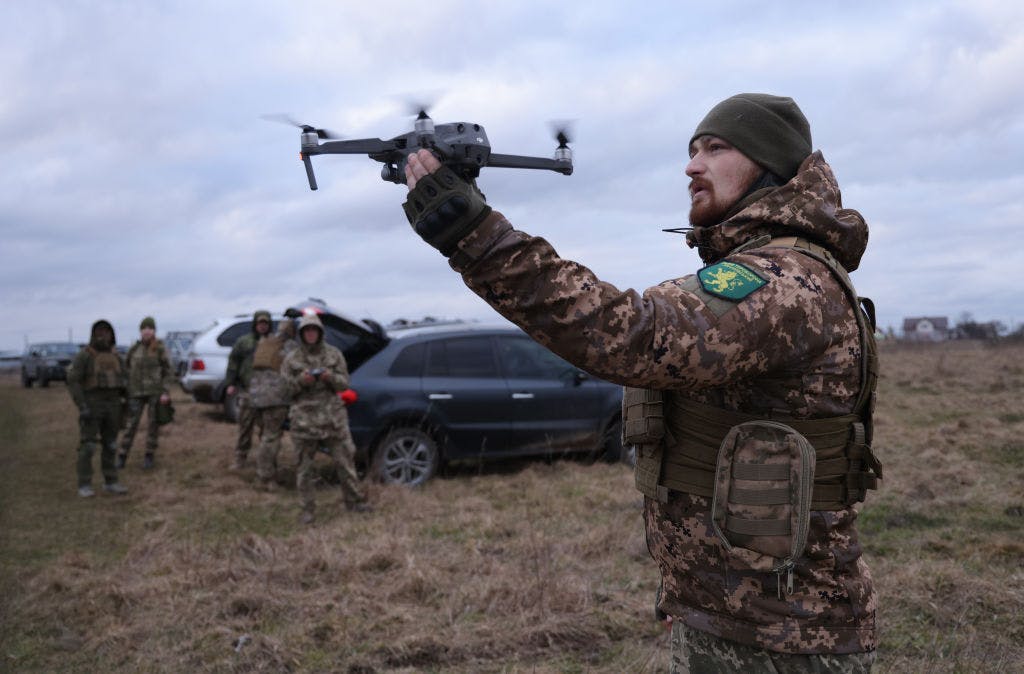Nightmare for Russia: Attack of the Kamikaze Chinese Drones
Blogger known as ‘Russian Engineer’ claims Ukraine plans to swarm enemy forces with 100,000 deadly kamikaze drones.

Wearing video goggles, 1,000 newly Ukrainian-trained drone operators plan to fly swarms of small but deadly Chinese-made kamikaze drones across southeastern Ukraine’s front lines next month. This futuristic vision of warfare is not the nightmare of Russian military planners tossing in their sleep but of a Russian military blogger known as “Russian Engineer.”
In a blog post that drew 2.1 million readers, Russian Engineer claims that Ukrainian military cutouts cornered the market last winter on cheap, racing drones produced by the world’s largest drone producer, DJI Technology Company. The Russian blogger claims that the Ukrainians have bought up to 100,000 of these drones from the Shenzhen-based producer.
The identity of the individual who goes by the handle Russian Engineer is not known. He cites informed sources and his blog is pro-Russian in outlook and gives critical support to the Russian military operation in Ukraine. He posts almost daily.
Responsible for about 75 percent of the world drone market, DJI says it banned sales to Russian and Ukraine last year, claiming it “abhors any use of our drones to cause harm.” Yet Communist China, a mercantilist superpower, seeks to be everyone’s friend. After European leaders fretted about China’s “no limits” partnership with Russia, China’s envoy to the European Union, Fu Cong, soothed feathers last week by claiming that China’s cooperation with Europe is “endless.”
Last month, the Chinese leader, Xi Jinping, spent three days at Moscow on a state visit. Today, Mr. Xi had a one-hour telephone call with President Zelensky. In a clear bid to play peacemaker, Mr. Xi promised to dispatch Beijing’s former ambassador to Moscow, Li Hui, to visit Ukraine and other countries in the region. His goal, China’s state press reports, will be to seek a “political resolution of the Ukraine crisis and conduct deep dialogue with all parties.”
While Chinese officials adopt Russian talking points on the war in Ukraine, Beijing officially says it is neutral. Mr. Xi’s visit to Moscow did not yield public announcements of weapons shipments. Two weeks ago, China’s new defense minister, Li Shangfu, made his own three-day visit to Moscow. He met with the two main architects of Russia’s war against Ukraine, President Putin and Russia’s defense minister, Sergei Shoigu. Once again, no news of weapons shipments filtered out of the meetings.
Separately, China reportedly declined arms requests made in January by a close ally of MR. Putin, the head of the Wagner military group, Yevgeny Prigozhin. Wagner “sought munitions and equipment” from China, the Financial Times reports, citing 100 highly classified American documents allegedly posted online by a 21-year-old member of the Massachusetts Air National Guard.
China “had not sent any weapons, not even for testing, and had no contact with [Wagner] regarding weapons deliveries,” according to the report. As recently as today, Mr. Prigozhin complained on his Telegram channel about critical ammunition shortages. Meantime, Ukrainian military officials report finding Chinese components in Russian weapons used in Ukraine.
Biden administration officials say they have no evidence of China sending lethal military equipment to help Russia in the war. Mr. Xi may be leaving his options open for a bigger goal. Peace in Ukraine — or at least a negotiated armistice — could be part of a larger package between China and America. The key may be a speech made last week by Secretary Yellen.
Ms. Yellen “offered détente with China in order to address the world’s problems together,” an Atlantic Council senior fellow, Diane Francis, writes in an essay titled “Ukraine’s Korea Solution.” Ms. Yellen’s speech, Ms. Francis writes, “contained an unspoken quid pro quo which is that if China helps terminate Russia’s war against Ukraine, protectionist measures against its economy will be lifted and trade will once more grow.”
A Russia scholar at Stanford University, Stephen Kotkin, said in a recent speech at Toronto: “The solution to the war is the U.S. and China getting together to impose an armistice on each side.” The quid pro quo would be: China reining in Russia in return for restored access to semiconductors and Western technology. To make the deal binding for Moscow, it would be signed in Beijing.
With Russia’s Wagner leader, Mr. Prigozhin, gloomily predicting today that Ukraine’s counter-offensive will start next week, China’s peacemaking move may be prompted by this military threat, a veteran Ukraine observer, Timothy Ash, writes today.
“Xi’s call might also have been all about stalling Ukraine’s looming spring offensive — Xi may actually be afraid that the Ukrainians might actually win,” Mr. Ash, who analyzes emerging markets in London for Bluebay Asset Management Company, writes. “So this latest call might just be about buying time for Putin — would Zelensky want to launch the counteroffensive so soon after the call with Xi, talking peace?”
As for “Russian Engineer,” the drone threat could be real next month. After reviewing Russia’s limited electronic warfare capacity, he makes three recommendations to Russian troops: Pull key equipment back from the front lines, cover front line equipment with camouflage netting, and fire at the Chinese-made drones with 12-gauge shotguns.

